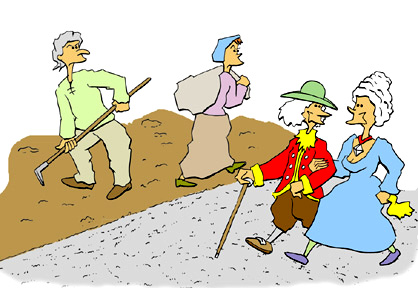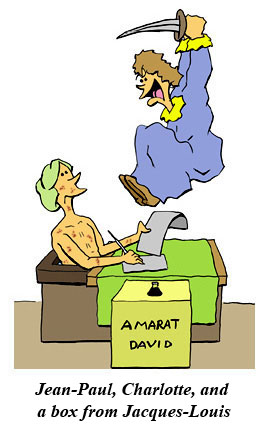|
|
|
Return to CooperToons Soundbytes of History |
A Most Merry and Illustrated Soundbyte of History of a Most Un-Merry and Un-Illustrative Era

You can't tell the good guys (or gals) from the bad guys (or gals)
Life in Gay Paree
The trouble with the French Revolution is you can't tell the good guys from the bad guys. Were the good guys the peasants who worked the fields and stormed the Bastille? Or was it the powdered, bewigged messieurs and the coiffured, decolletéd mesdames who patronized the great art of the French eighteenth century? Was King Louis XVI a good guy, but just stupid and naive? Was Marie Antoinette a good gal, but even more naive? Or were they greedy, indolent villains and despots living off the sweat of the poor?
One thing we can agree on, mes amis, and that was that the physician and journalist Jean-Paul Marat was a real jerk. You can't pooh-pooh him as a Republican who just got caught up in the zeal of the Revolution. He just flat out didn't like people and got his jollies chopping their heads off.
The Death of Marat
Jean-Paul met his end, as everyone knows on July 13, 1793 sitting in his bath. He had some kind of skin disease, and the constant soaking was the only way he could get relief. Paintings of him show a fellow with a clear complexion, but in reality it was both hard for people to look at him and not to stare.
If people had have had patience, Jean-Paul would certainly have been taken away with his buddy Robespierre at the National Convention a year later. But Charlotte Corday, a young lady from Caen, didn't know that. All she knew was Marat was a jackass who went around guillotining people and was turning what could have been a nice, quiet and reasonable revolution into nothing more than a vendetta bloodbath against political opponents.
So Charlotte wrote up a phony list of names and came knocking on Jean-Paul's door. She wanted, she told Jean-Paul's servant, to turn over the names of some traitors. Some people wonder why a young lady was allowed into the presence of a naked man. But this was France, after all, and no one thought anything about it.

At first Jean-Paul tried to give her the brush off, saying his list of traitors was fully subscribed, thank you. But Charlotte was so persistent that he told his servants to let her in. He'd add her traitors to the list he already had. As Jean-Paul was writing down a note authorizing everyone on the new list to be killed, Charlotte yanked out a knife and a quick stab did the trick. Jean-Paul only had time to call for help before he died. Charlotte got the usual speedy trial and went to the guillotine four days later.
Of course Jacques Louis David, the painter of great talent and even greater political flexibility, painted a picture of the episode. He also was a friend of Jean-Paul and Robespierre but, by golly, just happened to be absent from the Convention when Robespierre was deposed. But his painting of Marat in his bath was toted along in Jean-Paul's funeral, and if we can believe the painting, Jacques Louis had given Jean-Paul a present of a box to hold his ink bottle. At least that's what the writing on the box said.
Vive La Revolución (Perpetual)!
Even more perplexing than who were the good guys and bad guys in the French Revolution was when did that sucker end? Was it when Napoleon Bonaparte and two of his buddies were "elected" consuls? Or was it in 1804, when Nappy was crowned Emperor? Perhaps we should choose the later date, 1814 when Napoleon was finally defeated at Waterloo, and the kingship was restored. La Republique est mort! Vive les Bourbons!
But now that you think of it, maybe it's better to say the French Revolution ended in 1830 when the Bourbons were kicked out and replaced with their cousins from Orleans. But what about 1848 when the kings were finally once and for all kicked out of France and the Second Republic declared.
Or maybe it was 1850 when Napoleon's family was back in charge and Charles-Louis Napoleon Bonaparte (Joesphine's grandson) declared himself king. Of course, you can also say it was in 1870 when Napoleon's family was bounced out and another republic (the Third) was declared.
On the other hand, some people like 1871 when the Paris Commune declared it was the official government. But the Commune lasted only two months and was defeated by the Third Republic which had never lost power.
So the Third Republic is probably a good place to stop and say that once it was in power the Revolution was finally over. After all, The Third Republic lasted until 1940 when a guy named Phillipe Petain decided - quote - "neutrality" - unquote - was the way to go in World War II. So he was allowed to set up a new government called Vichy France which lasted until 1945.
Of course you can count the Provisional government from 1944 to 1946, but then that would be unfair to the Fourth Republic that came in afterwards.
But if you think about it and want to define the end of the revolution as we do ours - that is, when there was finally a government that they use today - then the French Revolution didn't really end until 1958 when France adopted their current constitution. That's the Fifth - count 'em - Fifth French Republic.
Well, if at first you don't succeed...
Return to CooperToons Soundbytes of History